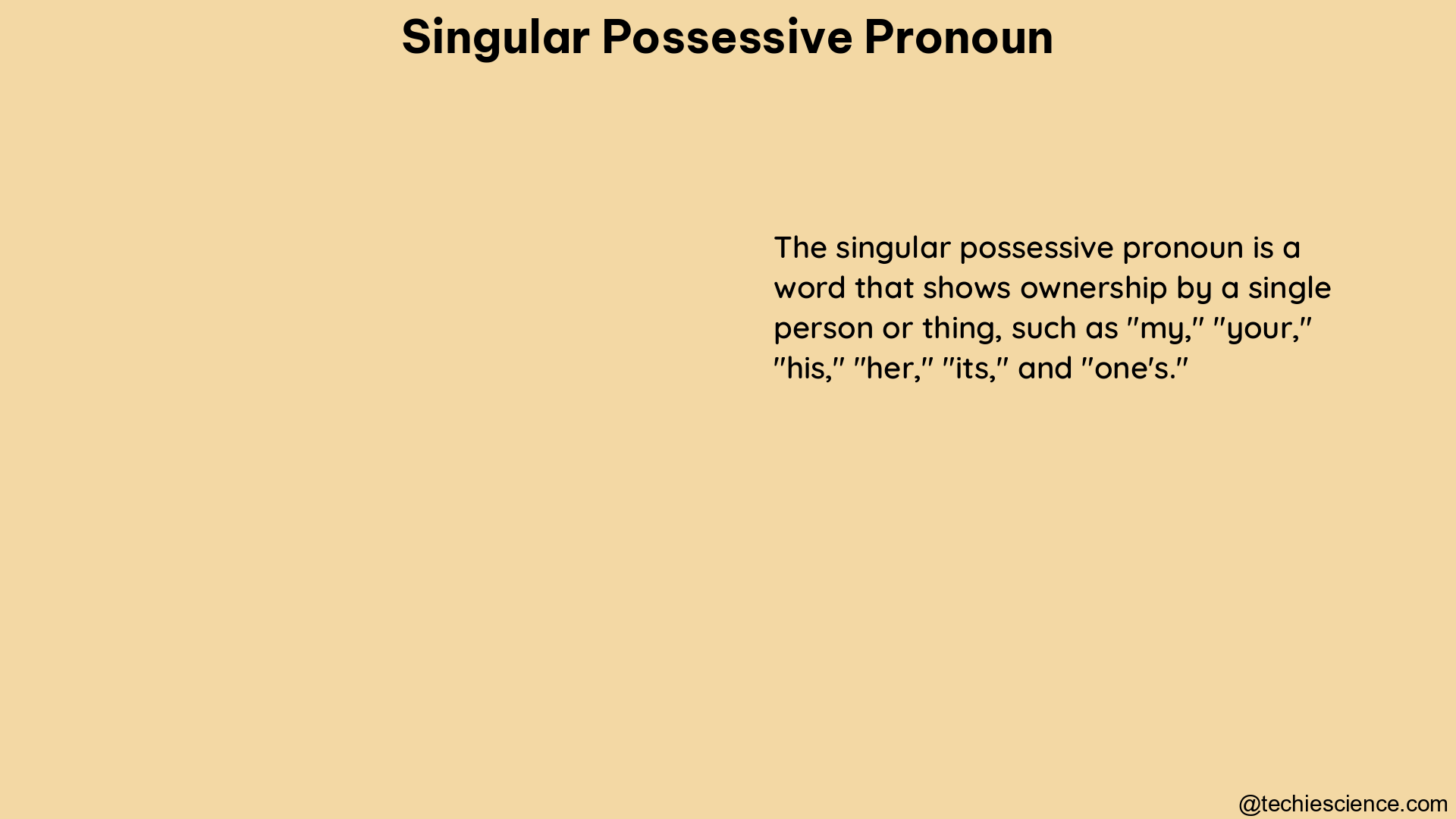Singular possessive pronouns are a crucial component of the English language, allowing us to concisely and efficiently express ownership or possession by a single person or entity. These pronouns play a vital role in streamlining our communication, replacing nouns and making our sentences more concise. In this comprehensive guide, we will delve into the intricate details and specifications of singular possessive pronouns, equipping you with the knowledge to use them with confidence and precision.
Specifications of Singular Possessive Pronouns
Number
Singular possessive pronouns refer to a single person or entity, distinguishing them from their plural counterparts. This distinction is essential in maintaining grammatical agreement and ensuring clear communication.
Person
Singular possessive pronouns can be used in the first person (e.g., “mine”), second person (e.g., “yours”), or third person (e.g., “his,” “hers”). Understanding the person of the pronoun is crucial for proper usage and agreement with the antecedent.
Gender
Singular possessive pronouns can be gender-specific, with “his” used for males and “hers” used for females. This gender-based distinction is an important aspect of singular possessive pronouns, allowing for precise and inclusive language.
Examples of Singular Possessive Pronouns

First Person
In the first person, singular possessive pronouns are used to indicate ownership or possession by the speaker or writer. For example, “This is mine.” (subject = my item)
Second Person
In the second person, singular possessive pronouns are used to indicate ownership or possession by the person being addressed. For instance, “I like your flowers. Do you like mine?” (object = my flowers)
Third Person
In the third person, singular possessive pronouns are used to indicate ownership or possession by a third party, either male or female.
Male
“All the essays were good, but his was the best.” (subject = his essay)
Female
“John found his passport, but Mary couldn’t find hers.” (object = her passport)
Key Points about Singular Possessive Pronouns
-
Usage as Subjects and Objects: Singular possessive pronouns can be used as both subjects and objects in sentences, depending on their role in the sentence structure.
-
Antecedent Reference: Singular possessive pronouns can refer to either singular or plural antecedents, as long as the pronoun agrees with the antecedent in person, gender, and number.
-
Agreement: Singular possessive pronouns must agree with the noun or noun phrase they replace in person, gender, and number. Ensuring this agreement is crucial for maintaining grammatical correctness and clarity.
Common Mistakes with Singular Possessive Pronouns
Improper Usage
Possessive pronouns should not be used as modifiers (adjectives or adverbs). They are intended to replace nouns, not to modify other parts of speech.
Agreement Issues
Failing to ensure that the possessive pronoun agrees with the noun or noun phrase it replaces in person, gender, and number can lead to grammatical errors and confusion.
Advanced Considerations
Singular Possessive Pronouns and Indefinite Antecedents
Singular possessive pronouns can be used with indefinite antecedents, such as “someone” or “anyone,” to indicate ownership or possession. In these cases, the pronoun must agree with the indefinite antecedent in person and number, but not necessarily in gender.
Example: “If anyone left their umbrella, they can pick it up at the front desk.”
Singular Possessive Pronouns and Collective Nouns
When the antecedent is a collective noun, such as “team” or “family,” the singular possessive pronoun must agree with the collective noun in number, even if the collective noun refers to multiple individuals.
Example: “The team celebrated its victory with a team dinner.”
Singular Possessive Pronouns and Compound Subjects
When the antecedent is a compound subject, the singular possessive pronoun must agree with the entire compound subject, not just the nearest noun.
Example: “Both John and Mary brought their books to the study session.”
Conclusion
Mastering the use of singular possessive pronouns is a crucial step in developing proficient English language skills. By understanding the specifications, examples, and key points outlined in this comprehensive guide, you can confidently and accurately employ these essential pronouns in your written and spoken communication. Remember to pay close attention to agreement, avoid common mistakes, and consider the advanced applications of singular possessive pronouns to elevate your language skills to new heights.
Reference:
- EnglishClub – Possessive Pronouns
- Grammarly – Possessive Nouns and Pronouns
- Scribbr – Possessive Pronouns
Hey! I am Arpita Bose Roy. My qualifications are M.A. in English with B. Ed. in both general education and special education. I have 2 years of experience as a “language analyst” at IIT Kharagpur and 4 years of experience as an “Academic Content Developer” at IIT Kharagpur. Currently, I am working as an academic writer at Lambdageeks.